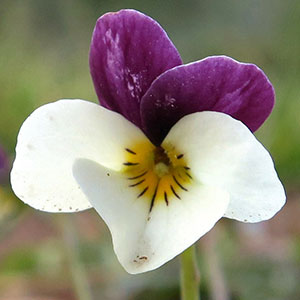Viola hallii
Viola septemloba
Hall's violet, Oregon violet, wild pansy
southern coastal violet
1–3, decumbent or ascending to erect, ca. 1/2 subterranean, glabrous, clustered on single, short, vertical, deep-seated caudex.
basal and cauline;
basal: 1–4, palmately compound, ± 2-ternate or 3-ternate, leaflets 3;
stipules adnate to petiole, forming 2 linear-lanceolate wings, unlobed, margins entire, apex of each wing free, acute;
petiole 5–8 cm, glabrous;
blade ovate to deltate, 2.8–6 × 2.6–6.5 cm, ± coriaceous, base tapered, ultimate lobes narrowly elliptic, lanceolate, or oblanceolate, 1–7 mm wide, margins entire, ciliate or eciliate, apex acute, mucronulate, surfaces glabrous;
cauline similar to basal except: stipules usually lanceolate, sometimes broadly ovate, ± leaflike, margins toothed;
petiole 1.3–6 cm;
blade 2–4.8 × 1.2–5.5 cm.
basal, 5 or 6, prostrate to ascending;
stipules linearlanceolate, margins entire, apex acute;
petiole 1.5–7 cm, usually glabrous;
earliest leaf blades ± ovate, sometimes 3-lobed, mid-season blades 7–9-lobed, 1–9 × 1–10 cm, base broadly cordate to cordate, middle lobes narrowly elliptic, lanceolate, spatulate, or obovate, (rarely linear), lateral lobes lanceolate or spatulate to falcate, margins usually entire, sometimes serrate, sometimes with narrowly deltate or falcate appendages or teeth, ciliate or eciliate, apex acute to mucronulate, surfaces usually glabrous.
2.5–11 cm, glabrous.
2–20 cm, usually glabrous.
sepals lanceolate to ovate, margins ciliate, auricles 0.5–1 mm;
petals: upper 2 almost black abaxially, dark reddish violet adaxially, lower 3 pale yellow, cream, or ± white, lateral 2 bearded, with deep yellow to orange patch basally, dark reddish violet-veined, lowest with deep yellow to orange patch basally, dark reddish violet-veined, 5–18 mm, spur yellow, gibbous, 0.5–2 mm;
style head bearded; cleistogamous flowers absent.
sepals lanceolate to ovate, margins ciliate or eciliate, auricles 0.5–1 mm;
petals light to dark blue-violet on both surfaces, lower 3 and sometimes upper 2 white basally, lower 3 darker violet-veined, lateral 2 densely bearded, spur sometimes bearded, lowest 15–25 mm, spur usually lilac, sometimes whitish, gibbous, 2–3 mm;
style head beardless; cleistogamous flowers on ascending to erect peduncles.
ellipsoid, 4–12 mm, glabrous.
ellipsoid, 11–14 mm, glabrous.
light brown, shiny, 3.2–3.5 mm.
beige, mottled to bronze, 2–3 mm.
= 60, 72.
= 54.
Viola hallii
Viola septemloba
Viola hallii was discovered on the grounds of Willamette University in Salem, Oregon, by Elihu Hall, a professor at that institution (V. B. Baird 1942). Leaves of V. hallii are similar to V. beckwithii.
(Discussion copyrighted by Flora of North America; reprinted with permission.)
For years this heterophyllous species was either ignored or included in Viola palmata. C. L. Pollard (1898) and E. Brainerd (1910, 1921) treated it as V. insignis Pollard, a later homonym.
(Discussion copyrighted by Flora of North America; reprinted with permission.)


